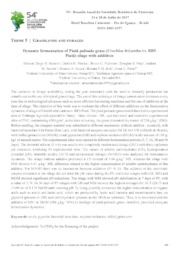Dynamic fermentation of Piatã palisade grass (Urochloa brizantha cv. BRS Piatã) silage with additives.
Dynamic fermentation of Piatã palisade grass (Urochloa brizantha cv. BRS Piatã) silage with additives.
Author(s): SEDANO, A. D. B.; PEREIRA, D. H.; PEDREIRA, B. C. e; PINA, D. S.; XAVIER, I. M.; SOUZA, H. A.; JOSÉ, R. P. D.; FARIA, A. C.
Summary: The variation in forage availability during the year associated with the need to intensify production has contributed to the use of tropical grass silage. The use of this technique of forage conservation increases every year due to technological advances such as more efficient harvesting machines and the use of additives at the time of silage. The objective of this work was to evaluate the effect of different additives on the fermentative dynamics of silage of Urochloa brizantha cv. BRS Piatã. The piatã palisade grass established in the experimental area of Embrapa Agrossilvipastoril in Sinop - Mato Grosso / BR, was harvested and ensiled in experimental silos of PVC, maintaining 650 kg/m3, at the time of cutting, the grass presented dry matter of 230 g.kg-1 (DM). Before ensiling, the chopped material was submitted to different treatments: without additive - (control), with bacterial inoculant Sila Prime (Star Lab), with bacterial anzyme-inoculant Sil All 4x4 SW (Alltech do Brasil), with milled ground corn (MGM); crude glycerine (GB) and soybean molasses (MGM) in the amount of 100 g/ kg1 of natural matter. The experimental silos were opened in different fermentation periods (3, 7, 14, 28 and 56 days). The factorial scheme (5 x 6) was used in the completely randomized design (DIC) with three replicates per treatment, totalizing 90 experimental silos. The values of soluble carbohydrates (CS), hydrogenation potential (pH), titratable acidity (ACT) and ammoniacal nitrogen (N-NH3) were analyzed for fermentative dynamics. The silage without additive presented a CS content of 5.66 g.kg-1 MS, whereas the silage with MSJ showed 6.41 g.kg-1 MS, difference related to the higher concentration of soluble carbohydrates of this additive. For N-NH3 there was no interaction between additives (P> 0.11). The addition of the microbialenzyme inoculant in the silage did not alter the pH value during the PF, while the silages with GB, MSJ and MGM showed significant pH reductions. The silage with MSJ showed pH stabilization at 7 days of PF, with a value of 3.78. At 56 days of PF silages with GB and MSJ showed the highest averages for ACT (20.75 and 19.60 ml of 0.1 N NaOH until reaching pH 7), being possibly connected the higher concentration of organic acids such as acetic and lactic acid, which are produced by lactic acid bacteria and enterobacteria that use glycerol (present in GB) and carbohydrates (present in the MSJ) as substrate. Thus, it is recommended the addition of MSJ or MGM (100 g.kg-1 MN) in ensilage of piatã palisade grass, therefore, provided adequate fermentative dynamics.
Publication year: 2017
Types of publication: Abstract in annals or event proceedings
Keywords: Bacterial inoculant, Crude glycerin, Glycerin, Soybean molasses, Soybeans
Observation
Some of Embrapa's publications are published as ePub files. To read them, use or download one of the following free software options to your computer or mobile device. Android: Google Play Books; IOS: iBooks; Windows and Linux: Calibre.
Access other publications
Access the Agricultural Research Database (BDPA) to consult Embrapa's full library collection and records.
Visit Embrapa Bookstore to purchase books and other publications sold by Embrapa.

